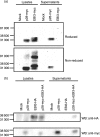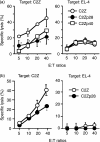The secreted form of p28 subunit of interleukin (IL)-27 inhibits biological functions of IL-27 and suppresses anti-allogeneic immune responses
- PMID: 19740343
- PMCID: PMC2753920
- DOI: 10.1111/j.1365-2567.2009.03088.x
The secreted form of p28 subunit of interleukin (IL)-27 inhibits biological functions of IL-27 and suppresses anti-allogeneic immune responses
Abstract
Interleukin-27 (IL-27) is a new IL-12-related heterodimeric cytokine comprising a novel p28 molecule and the Epstein-Barr-virus-induced gene 3 (EBI3) molecules. It augments initiation of T helper type 1-mediated immunity by enhancing the proliferation and cytokine production of T cells. In this study, we examined whether a secreted form of IL-27 subunits would inhibit IL-27-mediated immunological responses. COS-7 cells transduced with the mouse (m) p28 gene secreted a monomeric mp28 protein; however, those transduced with the mEBI3 gene did not detect a mEBI3 protein in the culture supernatants. The secreted mp28 prevented the IL-27-mediated signal transduction and activator of transcription 1 phosphorylation and subsequently inhibited the IL-27-mediated intercellular adhesion molecule-1 induction and interferon-gamma production in CD4(+) T cells. We generated mp28-expressing murine carcinoma Colon 26 cells and inoculated a mixture of the mp28- and mIL-27-expressing Colon 26 cells into syngeneic BALB/c mice. Simultaneous production of mp28 and mIL-27 from Colon 26 cells suppressed IL-27-mediated anti-tumour effects in the mice. We examined the p28-mediated immune suppression by inoculating mp28-expressing myoblasts into allogeneic mice. Forced production of mp28 suppressed the allogeneic cytotoxic T-lymphocyte induction and subsequently retarded the graft rejection. Furthermore, production of both mp28 and mp40, which inhibits the functions of IL-12 and IL-23, prolonged the graft survival longer than the grafts expressing either mp28 or mp40. We propose that p28 can be a regulatory subunit for IL-27-mediated cellular immune responses and a possible therapeutic agent to suppress unfavourable immune responses.
Figures






Similar articles
-
EBI3 deficiency leads to diminished T helper type 1 and increased T helper type 2 mediated airway inflammation.Immunology. 2011 Apr;132(4):559-66. doi: 10.1111/j.1365-2567.2010.03401.x. Epub 2011 Jan 24. Immunology. 2011. PMID: 21255010 Free PMC article.
-
The secreted form of the p40 subunit of interleukin (IL)-12 inhibits IL-23 functions and abrogates IL-23-mediated antitumour effects.Immunology. 2006 Jan;117(1):22-8. doi: 10.1111/j.1365-2567.2005.02257.x. Immunology. 2006. PMID: 16423037 Free PMC article.
-
Expression of IL-27 in murine carcinoma cells produces antitumor effects and induces protective immunity in inoculated host animals.Int J Cancer. 2005 Jun 20;115(3):437-42. doi: 10.1002/ijc.20848. Int J Cancer. 2005. PMID: 15688376
-
The power of combinatorial immunology: IL-12 and IL-12-related dimeric cytokines in infectious diseases.Med Microbiol Immunol. 2004 Feb;193(1):1-17. doi: 10.1007/s00430-003-0186-x. Epub 2003 Jun 27. Med Microbiol Immunol. 2004. PMID: 12836019 Review.
-
Modulation of inflammation by interleukin-27.J Leukoc Biol. 2013 Dec;94(6):1159-65. doi: 10.1189/jlb.0213107. Epub 2013 Jul 31. J Leukoc Biol. 2013. PMID: 23904441 Free PMC article. Review.
Cited by
-
New directions in the basic and translational biology of interleukin-27.Trends Immunol. 2012 Feb;33(2):91-7. doi: 10.1016/j.it.2011.11.003. Epub 2011 Dec 15. Trends Immunol. 2012. PMID: 22177689 Free PMC article. Review.
-
Multifaceted Analysis of IL-23A- and/or EBI3-Including Cytokines Produced by Psoriatic Keratinocytes.Int J Mol Sci. 2021 Nov 23;22(23):12659. doi: 10.3390/ijms222312659. Int J Mol Sci. 2021. PMID: 34884474 Free PMC article.
-
Decoding the Role of Interleukin-30 in the Crosstalk Between Cancer and Myeloid Cells.Cells. 2020 Mar 4;9(3):615. doi: 10.3390/cells9030615. Cells. 2020. PMID: 32143355 Free PMC article. Review.
-
The role of selected cytokines from the interleukin 1 family in the pathophysiology of morphea.Arch Dermatol Res. 2025;317(1):812. doi: 10.1007/s00403-025-04303-x. Epub 2025 Jun 16. Arch Dermatol Res. 2025. PMID: 40535350 Free PMC article.
-
Epstein Barr virus-induced 3 (EBI3) together with IL-12 negatively regulates T helper 17-mediated immunity to Listeria monocytogenes infection.PLoS Pathog. 2013 Sep;9(9):e1003628. doi: 10.1371/journal.ppat.1003628. Epub 2013 Sep 19. PLoS Pathog. 2013. PMID: 24068935 Free PMC article.
References
-
- Pflanz S, Timans JC, Cheung J, et al. IL-27, a heterodimeric cytokine composed of EBI3 and p28 protein, induces proliferation of naive CD4+ T cells. Immunity. 2002;16:779–90. - PubMed
-
- Morishima N, Owaki T, Asakawa M, Kamiya S, Mizuguchi J, Yoshimoto T. Augmentation of effector CD8+ T cell generation with enhanced granzyme B expression by IL-27. J Immunol. 2005;175:1686–93. - PubMed
-
- Yoshimoto T, Okada K, Morishima N, et al. Induction of IgG2a class switching in B cells by IL-27. J Immunol. 2004;173:2479–85. - PubMed
Publication types
MeSH terms
Substances
LinkOut - more resources
Full Text Sources
Other Literature Sources
Research Materials

